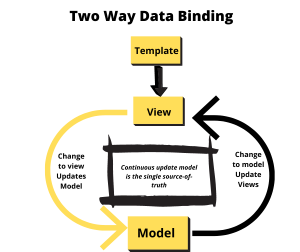In the event that you’ve not got your hands on AngularJS at this point, you’re missing incredible highlights that can truly benefit as much as possible from HTML for web applications. Unlike Backbone.js and Ember.js, AngularJS is a cutting edge JavaScript structure where every part works with all other components in an interconnected manner to make your web applications stick out. AngularJS ultimate guide is intended to give more accurate information on AngularJS, a primary structural framework for dynamic web applications, without skimming a great deal of needless stuff.
INTRODUCTION OF ANGULARJS
AngularJS is an open-source web application system plan with the point of making improvement and testing assignments much simpler for web engineers. It is a completely extensible customer side MVC/MVVM structure or framework that runs with no library conditions and functions admirably with different libraries. Being uncorrupted JavaScript, AngularJS is ideal for making one-page web applications that just require customer-side languages, for example, HTML, CSS, and JavaScript. Interestingly, you’re permit to adjust or replace any component to accommodate your special advancement work process and test necessities.
Causing you to structure and test your Javascript code better, AngularJS shows the program how to be an ideal band together with any worker addition by utilizing confidence infusion and reversal of control. In short, the principal objective of this underlying structure is to increase web applications with MVC (Model–View–Controller) capacity.
Table of Contents
NOTABLE FEATURES OF AngularJS
In contrast to numerous different structures, AngularJS is a high-level system that makes them extraordinary highlights which are similarly useful for developers as well as designers. The following are some stunning highlights of AngularJS, which empower engineers to make cutting edge web applications.
DIRECTIVES
Directives are the most remarkable, prevailing, and incredible component accessible just in AngularJS. Permit developers to make the custom and reusable HTML segments, which can be utilized to hide complex DOM structures. They authorize you to expand your HTML by allowing you to design a new HTML sentence structure and teach AngularJS to join its usefulness into the page. Introduced with ng-, the entirety of the Directives occur in HTML credits and work as independent components.
Some of the most used directives in AngularJS-
- ng-application: This directive announces a component as the application’s root component and is ordinarily positioned in the <body> or <html> labels. <html ng-app> is completely expected to announce a page as an Angular application.
- ng-tie: It replaces the content substance of an HTML part with the estimation of connection, and updates the content substance with the progressions made in the estimation of that articulation.
- ng-regulator: In order to characterize a JavaScript regulator class in order to assess HTML connections.
- ng-model: The ng-model trait is like ng-tie, aside from it is answerable for two-way information authoritative between the degree characterize in the model and the view.
- ng-rehash: This starts up by a layout once per thing, to which the circle variable is set, from a collection.
- ng-class: This order permits class ascribes to stack powerfully.
- ngIf: If articulation directive is utilize to re-embed or dispense with a component from the DOM. Dependent upon whether the condition is true or false.
- ng-stow away and ng-show: According to Boolean articulation’s worth, these traits restrictively show or cover a component.
WHAT IS DATA BINDING IN AngularJS?
Data binding is the second generally incredible and convincing element of AngularJS. It takes out a lot of pointless code you’ve to compose by delivering the worker backend from different templated fundamentals. By 80% code base of an average web application is commit to control, navigating, and tuning in to DOM occasions. Angular’s data binding hides this code, allowing you to focus on other regions of your web application.
In most of the templating frameworks, data binding happens just one way. The traditional layout framework combines the format and model into a view. This one-time combination, changes made in the model parts, and different segments of the view are not reflected in the view naturally. Any modifications made by the client to the view are likewise not reflected in the model. To continually adjust the model with the view and the view with the model, developers need to physically control the components and characteristics of DOM.
If a client rolls out any improvement to the view, this cycle turns out to be significantly more difficult. So, as a result, the developer is answerable for decoding the client interactions, combining them into the model. Then refreshing the model at whatever point any progressions happen in the view.
There are two types of data binding-
TRUST INJECTION
AngularJS carries an essential injector subsystem that is accountable for making parts and looking into conditions. Then pass them to different segments when required. Trust injection by AngularJS empowers engineers to announce how the web application is wired. By utilizing dependency injection, AngularJS conveys conventional administrations. Like view-subordinate regulators – from the worker side to web applications on the customer side. A significant part of the weight on the server backend decreases by bringing about a lot of lighter web application.
Hope you find our AngularJS: Ultimate Guide for starters informative, and helpful. Connect with us on social media: FACEBOOK | LINKEDIN
Tell me your opinion about AngularJS Ultimate Guide in the remarks beneath:
- Have I missed any of the AngularJS ultimate guide highlights?
- Have you made any extraordinary applications utilizing AngularJS?
- What’s your opinion on the future of AngularJS?

 Angular
Angular  NodeJS
NodeJS  MongoDB
MongoDB  .Net
.Net  Android
Android  React
React  PHP
PHP  MySQL
MySQL 


